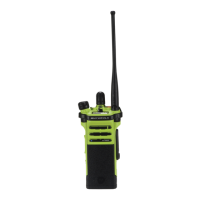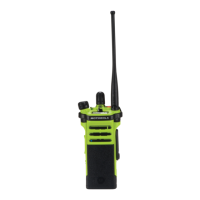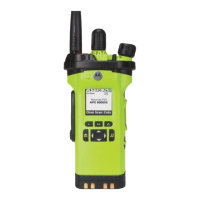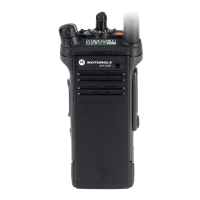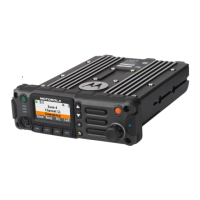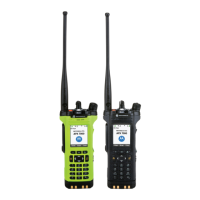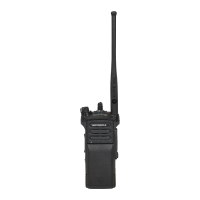Do you have a question about the Motorola APX 6000XE 1.5 and is the answer not in the manual?
Outlines legal protections, trademarks, and licensing terms for the product.
Mentions Open Source software and EU/UK WEEE disposal requirements.
Notes on feature applicability, system configurations, and contact details.
Explains manual notations, basic radio maintenance, cleaning, and handling guidelines.
Information on authorized service, repair procedures, and battery recycling programs.
Topics to consult with dealer/admin, like radio settings and optional accessories.
Instructions for charging, attaching the battery, and attaching the antenna.
Procedures for accessory cover, carry holder, belt clip, power on, and volume adjustment.
Identifies and describes the physical components and buttons of the radio.
Details how programmable buttons, switches, and settings function.
Explains battery charge indicators, HAZLOC alerts, and protection mode.
Describes the meaning of LED light patterns and various icons on the display.
Features that use display backlight and audible tones for notifications.
How to navigate between zones and select radio channels.
Procedures for handling incoming talkgroup, private, and telephone calls.
Steps for initiating talkgroup, private, and enhanced private calls.
Switching modes and using the monitor feature for channels.
Covers enhanced data, system resilience, encryption, and rekeying.
Discusses P25 DVRS and improvements to conventional scan.
Virtual assistant for information lookups using voice commands.
Covers selective calls, priority dispatch, and dynamic regrouping.
Managing scan lists, priorities, and scan modes.
Covers emergency modes, scenarios, activation, and keep-alive features.
Features for incident scenes, evacuation, tactical ops, and fall detection.
Selecting secure transmissions and managing encryption keys.
Using GPS for location tracking and virtual perimeters.
Managing trunking operations and broadband connectivity.
Connecting accessories via Bluetooth and reporting sensor events.
Over-the-air programming, audible alerts, and Wi-Fi connectivity.
Functions like flip display, zone banks, power levels, backlight, and keypad lock.
Managing transmission timers, audio filtering, and stopping transmissions.
Information on FCC certified accessories for the radio.
General disclaimers, FCC conformity, and licensing requirements.
RF energy exposure and product safety guidelines.
Information on obtaining a Canadian radio license.
Guidelines for emergency channels, non-commercial use, and operating frequencies.
Details warranty coverage, general terms, and how to get service.
Lists items not covered by warranty and governing law.
Specific warranty terms applicable to Australian consumers.
Outlines legal protections, trademarks, and licensing terms for the product.
Mentions Open Source software and EU/UK WEEE disposal requirements.
Notes on feature applicability, system configurations, and contact details.
Explains manual notations, basic radio maintenance, cleaning, and handling guidelines.
Information on authorized service, repair procedures, and battery recycling programs.
Topics to consult with dealer/admin, like radio settings and optional accessories.
Instructions for charging, attaching the battery, and attaching the antenna.
Procedures for accessory cover, carry holder, belt clip, power on, and volume adjustment.
Identifies and describes the physical components and buttons of the radio.
Details how programmable buttons, switches, and settings function.
Explains battery charge indicators, HAZLOC alerts, and protection mode.
Describes the meaning of LED light patterns and various icons on the display.
Features that use display backlight and audible tones for notifications.
How to navigate between zones and select radio channels.
Procedures for handling incoming talkgroup, private, and telephone calls.
Steps for initiating talkgroup, private, and enhanced private calls.
Switching modes and using the monitor feature for channels.
Covers enhanced data, system resilience, encryption, and rekeying.
Discusses P25 DVRS and improvements to conventional scan.
Virtual assistant for information lookups using voice commands.
Covers selective calls, priority dispatch, and dynamic regrouping.
Managing scan lists, priorities, and scan modes.
Covers emergency modes, scenarios, activation, and keep-alive features.
Features for incident scenes, evacuation, tactical ops, and fall detection.
Selecting secure transmissions and managing encryption keys.
Using GPS for location tracking and virtual perimeters.
Managing trunking operations and broadband connectivity.
Connecting accessories via Bluetooth and reporting sensor events.
Over-the-air programming, audible alerts, and Wi-Fi connectivity.
Functions like flip display, zone banks, power levels, backlight, and keypad lock.
Managing transmission timers, audio filtering, and stopping transmissions.
Information on FCC certified accessories for the radio.
General disclaimers, FCC conformity, and licensing requirements.
RF energy exposure and product safety guidelines.
Information on obtaining a Canadian radio license.
Guidelines for emergency channels, non-commercial use, and operating frequencies.
Details warranty coverage, general terms, and how to get service.
Lists items not covered by warranty and governing law.
Specific warranty terms applicable to Australian consumers.
| IP Rating | IP67 |
|---|---|
| Battery Type | Li-Ion |
| Emergency Button | Yes |
| Operating Temperature | -30°C to +60°C |
| GPS | Yes |
| Bluetooth | Yes |
| Frequency Range | 136-174 MHz |
| Encryption | AES, DES-OFB, DES-XL |
| Display | Color LCD |
| Intrinsically Safe | Yes |
| Battery Life | Up to 12 hours |
| Weight | Approx. 500g (with battery) |
| Dimensions | 5.4" H x 2.9" W x 1.5" D (137 mm x 74 mm x 38 mm) |

